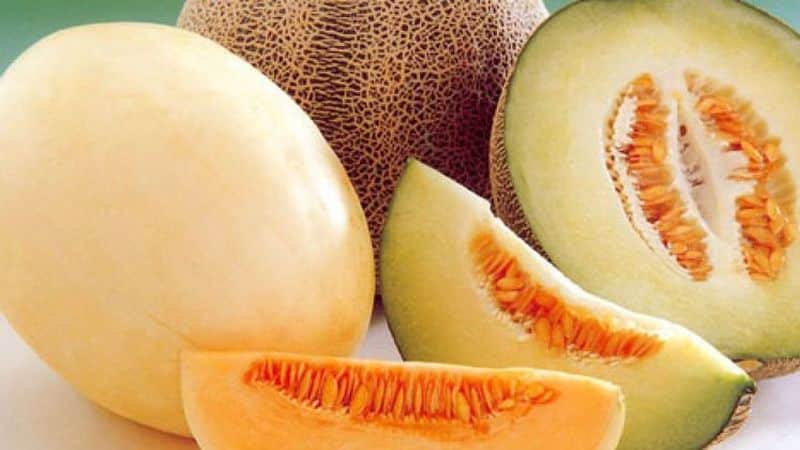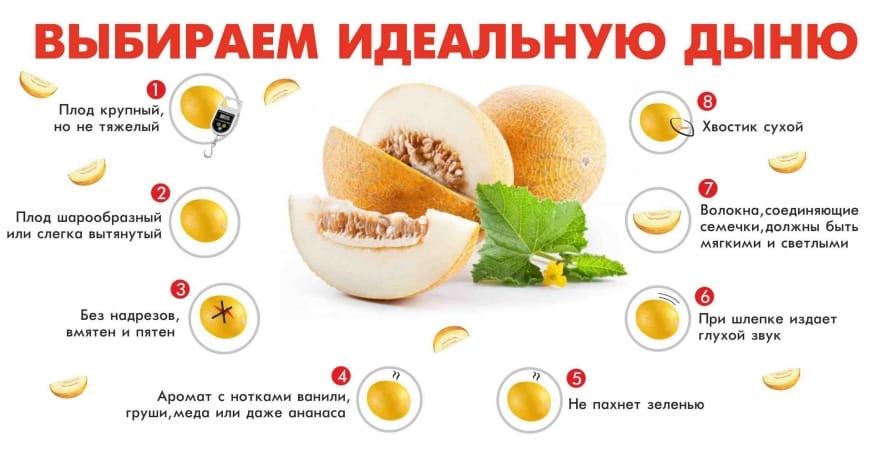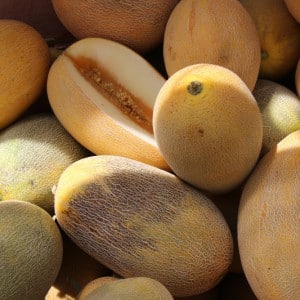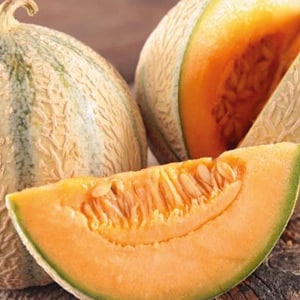Step-by-step instructions on how to choose the right melon: useful tips and life hacks for finding the most delicious fruit
The end of summer and the beginning of autumn are the most productive times of the year. Ripe vegetables, fruits and melons appear on sale at an affordable price. This period is ideal for buying aromatic melon. In this article you will find tips and recommendations for choosing ripe fruits, depending on the variety, appearance and aroma.
How to choose a good melon
To purchase a ripe and sweet melon, we recommend that you stock up on knowledge on how to determine the quality of the product by external signs, smell and taste and not waste money.
Appearance
What does ripe fruit look like? When choosing a melon, pay attention to the shape. It is different for each individual variety - round or oval. The main thing is that there are no bumps or dents on it. Such damage indicates non-compliance with the rules for transportation and storage of melons. Green blotches and uneven color are signs of unripe fruits.
Ripe melon is determined by dry scales. If they are easy to peel off, then everything is in order, take the fruit without fear. Inspect the fruit for cracks and cuts. In this case, you can be sure that no dirt or germs have gotten inside. GOST allows healed scratches.
Smell
The smell of melon never fails. Ripe fruits exude a sweet vanilla, pear or honey aroma. Therefore, if the melon looks ripe, but does not smell anything, put it back.
Sound
To correctly identify a good, ripe melon by sound, click your fingers on the surface. If you hear a ringing sound, it means it’s not ripe; a dull sound indicates that the fruit is ready to eat.
Tail
A dry tail and nose indicate that the melon was harvested ripe. If they are green, it means that the fruits have ripened under artificial conditions.
You've probably heard that melons are divided into female and male fruits. How to determine this? Pay attention to the stem: if it is dry and thick, it means there is a “girl” in front of you. It is these fruits that have sweet honey pulp.
Other criteria
Many people are accustomed to buying melons directly from the truck, thinking that the fruits have just been picked. In fact, this is not true. Often such sellers do not have the appropriate documents and product quality certificates. Harmful substances and heavy metals from the air accumulate in the melon peel. And with this storage method this is inevitable.
Buy melons only at official retail outlets - supermarkets and markets. The larger the store, the more thoroughly the products are checked.
Important! At market outlets, ask for permission to trade and certificates with laboratory test results.
Often at the market we are offered to try a piece of melon to evaluate its taste. This approach to sales is dangerous to your health. There can be no question of any sterility and hygiene of the seller. Just imagine how a person cuts off a piece of dirty fruit with unwashed hands. You will have an upset stomach, and in the worst case, salmonellosis.
When growing melons, nitrates and toxic substances are used to accelerate ripening. Such fruits do not have a strong aroma; green blotches are noticeable on the skin.If, after cutting, you notice gray-colored seeds, it is better to avoid eating the melon. Moreover, its taste will definitely not please you. To prevent nitrates from entering your body, do not eat the flesh adjacent to the skin. After all, it is in it that harmful substances accumulate.
The nuances of choosing melon depending on the variety
There are a large number of varieties of melons, but the most commonly found on sale are Torpedo, Ethiopka and Kolkhoznitsa. They are stored better than others and can withstand transportation. In the south of Russia, the varieties Galileo, Cantaloupe, Altaiskaya, and Turkmenka are grown. Which one tastes better? It's hard to answer, because Each variety has its own advantages.
Choosing a melon Collective farmer, give preference to small fruits. Ripe fruits exude a strong aroma and have moderate sweetness. A dry tail and yellow-orange skin color are signs of a ripe fruit.
Torpedo variety It is extremely popular due to its dense structure and pronounced taste. How long should a Torpedo be? Ripe fruits have a pale yellow skin. The larger the specimen, the sweeter the pulp. The aroma of this melon is not as strong as, for example, that of Kolkhoznitsa.
Melon Ethiopian goes on sale in mid-August. To choose a tasty fruit, examine the skin. It should not have dark spots, dents or other damage. Ripe fruits are soft inside, have an orange-yellow color, a rough surface with a rough mesh. A dull sound when tapped indicates that the fruit is ripe. Press your finger in the area of the stalk: in a ripe Ethiopian it is soft, in an unripe one it is hard.
Variety Turkmenka - These are medium-sized fruits with yellow skin and a network of cracks on the surface. Melon ripens in mid-autumn.A honey aroma, dry tail, bright color and dull sound indicate ripeness. The surface should be dense and not pressed with your finger.
Read also:
How to make delicious and healthy melon juice at home.
Top 8 best recipes for preparing melon in syrup for the winter in jars.
Is it possible to eat melon on an empty stomach: benefits, harms and contraindications.
Lifehacks for choosing a good melon
When buying melons, use some tips to avoid disappointment:
- Smell the fruit. Ripe melon exudes a sweet aroma. If there is no smell, don't buy.
- Choose melons at retail outlets that are located away from the roadway. The skin of a good product is evenly colored, without greenery. A hard melon is unripe, and a too soft melon is overripe.
- Examine the fruit from all sides. Brown or gray spots, cracks and dents should alert you.
- Hold the fruit in your hands. Weightiness indicates maturity.
- After cutting, inspect the seeds. If they are easily separated from the pulp, the product is ready for use.
Conclusion
Choosing a tasty melon is a delicate matter, because the thick skin hides the juicy pulp. Try to buy melons at the height of the season, namely from mid-August. During this period, it is more difficult to buy unripe fruit.
Avoid spontaneous points of sale, take into account the rules that we have described, and enjoy the juicy and healthy pulp.